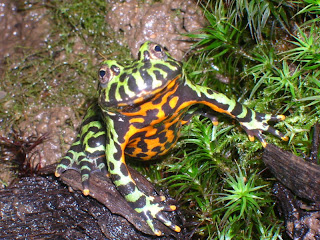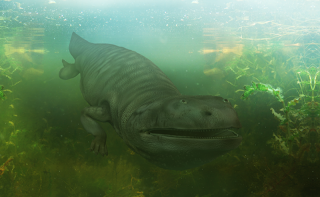I couldn't talk about the Sunbittern yesterday without talking about it's interesting cousin, the Kagu, today. For a fast refresher, the Sunbittern and the Kagu appear to be the only extant members of the Eurypygiformes Order, and both are the only living species in their Families. Despite being relatives, they live in opposite parts of the world-- the Sunbittern in Central America, and the Kagu in New Caledonia.
New Caledonia is a French territory in the Pacific Ocean, an archipelago about 750 miles east of Australia. The Kagu currently lives only in the dense, mountainous forests of the island of Grand Terre, and even though they live among the trees, they are actually a terrestrial species, and are almost completely flightless (they have full sized wings and can glide, but do not actually fly). The hunt for insects on the forest floor, and even build their nests on the ground.
The wings of the
Kagu are not used for flight, but they are used for mating, fighting, and defensive displays. When their wings are tucked in, they look like a plain, bluish-grey bird with long red legs. When their wings are out, however, they
show a striking barred pattern. They also have a head crest the sticks out during these displays, and it is that crest that gives them their species name,
jubatus (derived from Latin for "crested"). On a related note, the genus name
Rhynochetos, means "nose corn" and refers to the skin flaps on their noses that keep dirt out while they forage for insects.
Kagu pairs will form
monogamous bonds that can last throughout their lifetime. The couple will live alone in their territory, and will typically raise one chick per year. After fledging, chicks often hang around for several years, helping to defend the territory.
The Kagu is a national symbol of New Caledonia, and appears on various emblems. Sadly though, they are very Endagered, with less than 1,500 remaining in the wild. Their beautiful barred wing feathers made them popular targets for 19th century hat makers, and habitat loss and predation from cats and rats have led to a decline. Luckily they are now fully protected, and reintroduction and captive breeding efforts have been going well,
allowing the population to stabilize.
IUCN Status : Endangered
Location : New Caledonia
Size : Length up to 22in (55cm)
Classification : Phylum : Chordata -- Class : Aves -- Order : Eurypygiformes
Family : Rhynochetidae -- Genus : Rhynochetos-- Species : R. jubatus




















